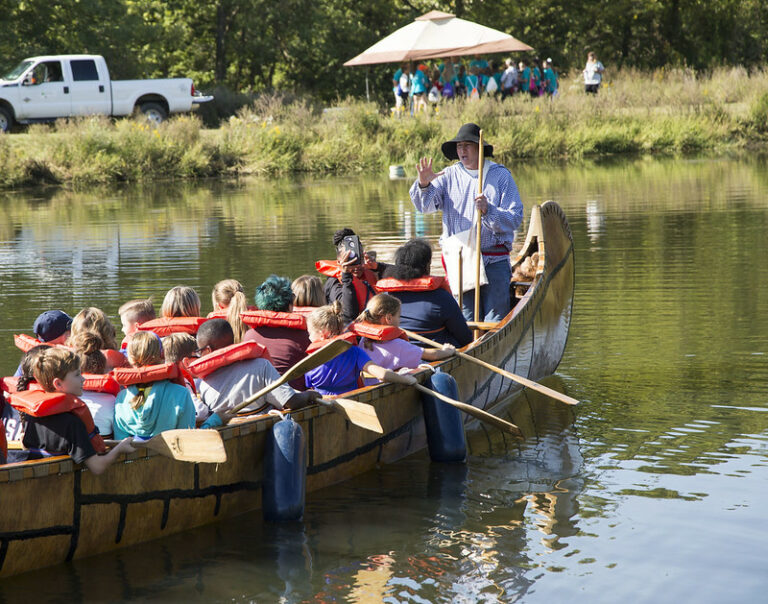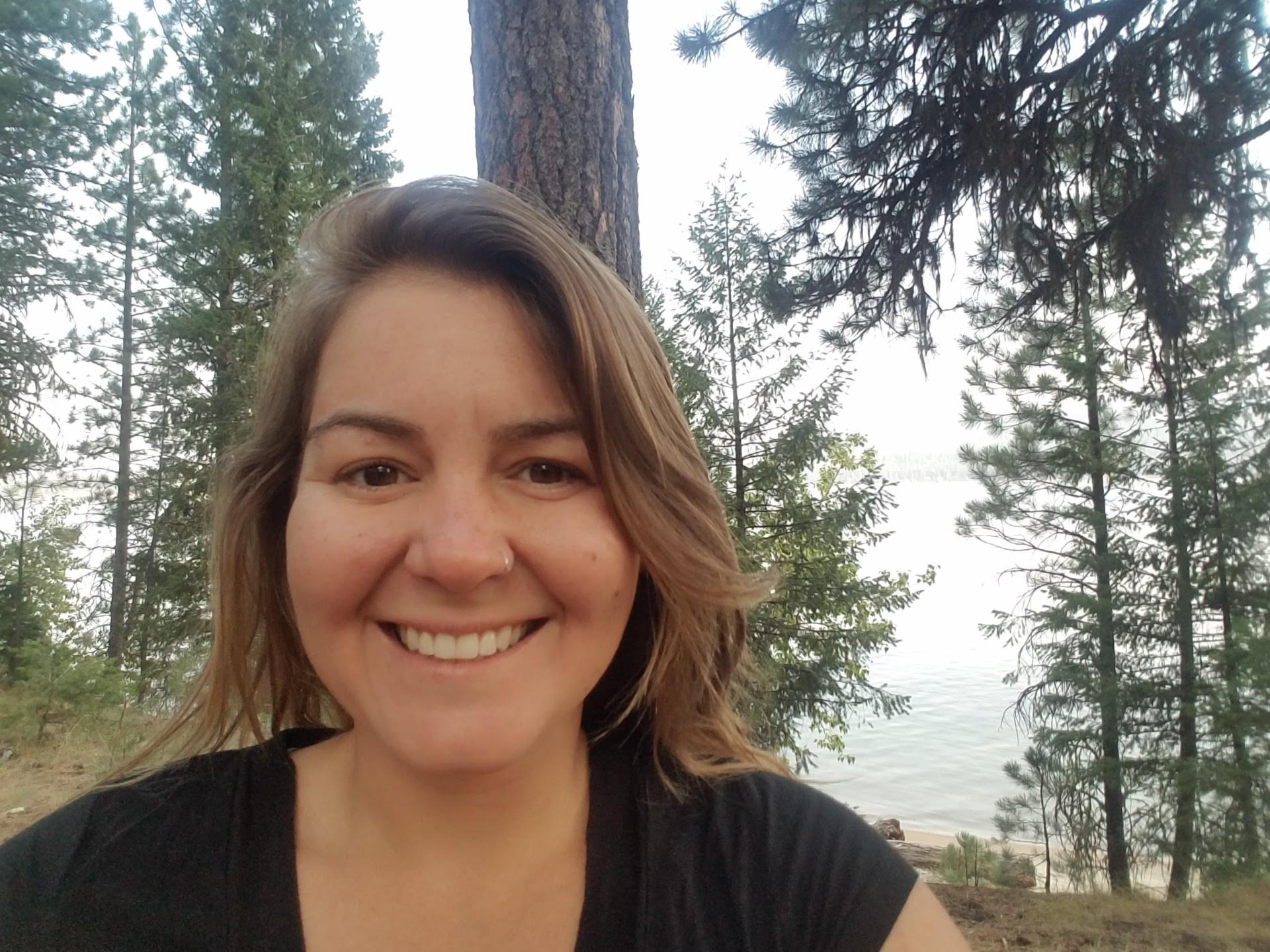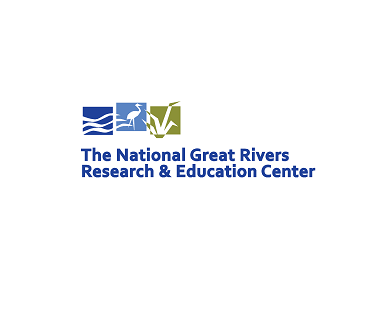
The National Great Rivers Research and Education Center hosts many enriching place-based environmental education opportunities and outreach efforts that are centered around serving local communities. Sarah Fisher is the director of environmental education and emphasizes the importance of student-driven exploration. ESAL discussed the importance of context on impact of environmental education efforts with Fisher.
MS: How did you become involved in environmental education?
Fisher: My parents sent me to summer sleepaway camp for eight summers when I was a kid. That was really the first time that I ever went camping or canoeing. I realized that it was wonderful and I loved doing stuff like that. My older cousin, when I was in maybe fourth grade, had done AmeriCorps. I had heard of AmeriCorps through her and I knew it was something you could do out of college that would provide you work experience. I taught in that program and as a classroom teacher, and I loved working in the schools, but I missed the environmental part of my job.
Several years later, I got a position at a place called the Canyon Country Discovery Center, which is just outside of Moab, Utah and it was my dream job. I got to take students whitewater rafting, hiking in the mountains, snowshoeing, and the whole time teaching them about the environment in the Abajo Mountains, the La Sal Mountains, the Colorado River and the San Juan River. A lot of the population I worked with at the Discovery center were Navajo students from the nearby reservation. I was kind of going back to the beginning of my education career working with indigenous students in New Mexico. I really enjoyed that position a lot, but then I got an offer to be the director of environmental education at the National Great Rivers Research and Education Center, which is where I am now.
MS: How does the NGRREC engage in local education outreach?
Fisher: We work with a program called TRIO, which is for first generation college students to learn about education and schooling. The students haven't really experienced much outside of their local communities. It's just not something those students have the opportunity to do very often. I was able to continue my love of educating diverse populations and bringing students and individuals outdoors that hadn't really experienced it much before and hadn't had the opportunity to really go in depth to learn about the environment. We try to focus a lot of our education efforts on the more underserved students from communities like East St. Louis and the Jennings school district in St. Louis.

Sarah Fisher.
MS: How does your facility support environmental outreach?
Fisher: Our biological field station is right on the bank of the Mississippi River. Our field station is a LEED certified gold facility, and the building itself is a phenomenal teaching tool. We teach the students about the different environments throughout Illinois, and we can take them to a lot of those environments and show them. One of the things we do a lot is take some water from our pond and take some water from the river, and we have the students compare and contrast the river by doing a series of scientific experiments. They also use chemistry kits that are also used by our research scientists to study the same things like pH, dissolved oxygen, turbidity, nitrates, and chlorides.
MS: What is an example of how the local environment in Illinois has allowed for outreach opportunities?
Fisher: A little bay called Ellis Bay is part of a migratory bird sanctuary. The Mississippi River is the largest flyway in North America. So we have the migratory birds right across the river from our field station. And that's where we take the students a lot for canoeing. There are bald eagles, trumpeter swans, and American white pelicans. There are just phenomenal examples of bird species that you don't usually see.
MS: What are some successes that have come out of the environmental outreach programs led by NGRREC?
Fisher: A lot of the successes come from seeing the change in the students’ relationship with the environment. Sometimes we'll do week-long summer camps or we'll do once a month activities with students within the same classrooms. We survey them all with an external evaluator for efficacy. They will come back and tell us the student's perceptions and whether education efforts are actually working. In their pre-survey, students get asked questions about their connections to the environment, their understanding of the natural world around them, how important it is to them, etc. The surveys are mixed at the beginning, but the thing we always see by the end is that most surveys say that the students learned a lot. They really enjoy the outdoors. Some of them report that they didn't know they liked being outside at all. There are just very few people that utilize outdoor opportunities around here. One of our biggest successes is just to show people these opportunities exist.
We also offer undergraduate internships. I got an email from an intern from 2014 the other day and she was just saying how integral the internship program was to her science education. Now she's actually a professor. We have another student intern and she worked on an internship project last summer. Now she's done almost a year of research in this field and she does not plan to stop anytime soon. We see a lot of success stories from our student interns.

National Great Rivers Research and Education Center Logo
MS: Why do so few people take advantage of the outdoor spaces?
Fisher: The river runs through all of our communities in St. Louis. The river is seen as something to be feared in this community. There's a lot of flooding. Some people's homes are destroyed by flooding. The banks of the river are really built up with quite a bit of industry here. We used to have a coal fired power plant right next to our field station and they just decommissioned it about a year ago. There're just a lot of industries that own all the riverfront property. There's not a lot of access for students to just walk to the river in their communities.
MS: Why is it important to educate students in St. Louis about the Mississippi River?
Fisher: I believe that teaching science and ecology, the students are not going to connect with it as much unless they see the relevance to themselves. A lot of times in schools, from what I've observed, students will learn about mountains or oceans. Well, we don't really have mountains or oceans in Illinois. A lot of these students potentially have never seen a mountain or have never seen the ocean.
We can't just force science. We can't say “You're going to study the river. You're gonna like it.” So we dip their toes in it. We let them explore it for themselves. Then kids are curious. They want to know how things work. So we start getting asked questions and start getting deeper and deeper. Then all of a sudden we're teaching about terrestrial ecology, tertiary systems, food webs, and macro invertebrates within the river. The opportunities are endless. Once we get students asking these questions, we really try to steer our education programs in the way that the students are driving it.
MS: How are the environmental education programs at NGRREC unique from other programs?
Fisher: Something that's really neat is that all of our lessons are written to state standards. We use the board of education standards and Next Generation Science Standards, which are the standards within the state of Illinois and the nation. Within the state of Illinois earth sciences only was added to the standards list within the last few years. One of the things we're working on right now is getting teachers trained. We have teacher training institutes where we offer them professional development credits, which are required to re-license every two years within the state.
MS: Can you tell us more about the Water Festival Event?
Fisher: It’s our 20th anniversary of the Water Festival this year! We take local students and prioritize schools that we've never worked with before and schools that don't have access to this type of field trips or education in their own communities. We actually bring them to the main campus of Lewis and Clark Community College because there's a really beautiful creek and pond on campus. We invite all these community partners that are also working on water education and outdoor education and ecology and they set up booths. They create environmental education lessons that last about 20 minutes. Students rotate throughout these stations for the day. One of our stations is the water cycle. We have the student basically make the water cycle in a plastic bag and they tape it up and let it be exposed to the sun. You can see the water heating up and then kind of raining back down. The IDNR takes them fishing on the pond while also paddling a 14-person Voyager Canoe. The Water Festival encourages students to get outside more, learn about the importance of water in their communities and throughout the world, and to look at different forms of recreation within the river.
MS: Please tell us more about the Critical Interface Network Project.
Fisher: Critical zone science is an emerging field of science. The critical zone is defined as, basically, treetop to bedrock. There is something called the critical zone observatory network that is a grant funded by the National Science Foundation. It brings scientists from around the country working on critical zone science together to discuss the field. Faculty members at University of Illinois got a grant to continue this critical zone research called the critical interface network grant. So we're one of nine funded, critical zone science pods throughout the country.
The grant is a five year grant looking at the interfaces between the critical zones. So looking at the soil to water interface or the roots to soil interface, and even the roots to bedrock interface. We've done some really deep cores in these fields and brought up hundreds of years of scientific data through the rock and sediment that we found. My role in that grant is to direct the education efforts.
Our project really focuses on agriculture because Illinois is the breadbasket of America. So we're looking into precision methods where we can use satellite imagery data to look at farm fields. Instead of a farmer fertilizing an entire field, which is what's practiced right now because they don't know where they need it, they'll be able to just treat that one little acre. Not only does it solve the problem of decreasing runoff into local waterways, but it also saves farmers a lot of money. We've made a lot of great strides. We're just really excited to see where it goes from here.
MS: Where do you see informal environmental education in the future?
Fisher: I hope that the next generations of students will grow up with more of an appreciation for the world around them and want to spread that to their families. The working model for our organization is science to policy or science to education. I think things that we're really working for is seeing sound science make it into the community, not just through legislators, but also through students and teachers. Our education department right now is working a lot more locally. I believe that if we're not serving our own community and not well recognized in our community, then we shouldn't be expanding to other communities yet. I really see us first expanding to the greater Mississippi river basin, and then to other great rivers throughout the United States.
Are you involved with an organization or effort that you think might be of interest to the ESAL community? Or have heard about an organization or initiative that you’d like to learn more about? Let us know here, and we may feature it in a future post.